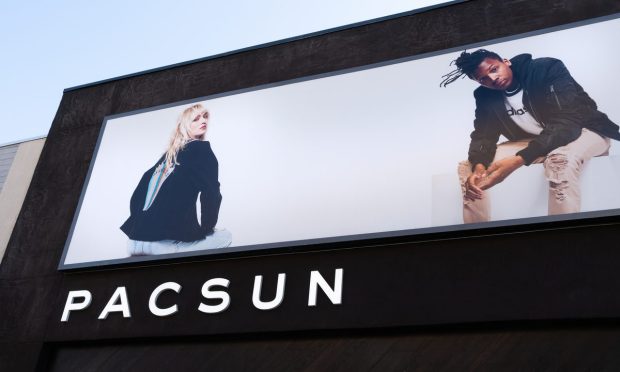Retailers Turn to Crypto, Social Commerce to Tap Gen Z Shoppers

Nearly one in five Americans, or 46 million consumers, say they would be likely to make a purchase with cryptocurrency, with over half of current or former cryptocurrency owners coming from Generation Z — which is why Alfred Chang, co-CEO of PacSun, says it’s becoming critical for merchants to consider.
“For this generation, we built our brand on remaining extremely relevant with things that are important to them and are part of their lifestyle,” Chang said in an interview with PYMNTS. “And while payment isn’t what we sell, it’s something that’s so part of their experience with us, so it’s therefore critical for us to make sure we started accepting cryptocurrency.”
The California-based youth fashion retailer said last week it would begin accepting bitcoin and other cryptocurrencies through blockchain payment provider BitPay, making it among the first major apparel merchants to do so. Other major retailers, including Amazon-owned Whole Foods, Nordstrom and GameStop, also accept cryptocurrency as payment through digital payment company Flexa’s SPEDN app.
Read more: Gen Z Fashion Retailer Pacsun Now Accepts Crypto
Also see: Big Retailers Like Whole Foods to Accept Bitcoin
“We did not launch it right now, because it’s something so commonly being used for physical payment of goods, or even digital payment of goods, in our space, but it is one that is very relevant right now,” Chang said. “It is something that every one of our consumers in this generation has grown up with as part of the conversation.”
Approximately 60% of cryptocurrency owners, and nearly 23% of nonowners, are “very” or “extremely” interested in using cryptocurrencies to make online purchases that are more private or secure, according to PYMNTS research conducted in collaboration with BitPay. Over 39% of consumers who would consider making clothing purchases using cryptocurrency say it would make online payments more efficient.
Read more: Report: Nearly 60% of Consumers Want to Buy Stuff With Crypto
Still, PYMNTS’ Connected Economy research shows that only 10% of highly connected consumers and 1% of moderately connected consumers have used cryptocurrencies to make purchases; lightly connected consumers did not use the payment method at all. Three-quarters of people who don’t own any cryptocurrency say they lack knowledge about it, and 33% say it’s not mainstream enough to invest in.
Chang noted that some people question whether consumers’ interest in crypto can last, and whether “it is really going to mean something,” but added that for him, it’s “really hard right now to believe that cryptocurrency is not going to mean something.”
“The question mark is at what scale and exactly how,” he added.
The Importance of Social Commerce
PacSun has recently also been focusing on growing its social media presence, particularly on TikTok, and connecting to customers through livestreamed shopping events. Chang said the retailer has hosted about a half-dozen livestreams so far.
“We’ve been able to launch exclusive products, experiences hosted by influencers, talking about the product,” he said. “We know that this consumer loves social media engagement, and … that’s what makes livestreaming so compelling now. It allows them to engage at a level beyond just comments on our posts or stories and TikToks.”
Chang noted that PacSun was among the first brands to “really understand” TikTok and start creating unique content for the platform, which helped grow its follower count from 80,000 early in the pandemic to 1.5 million currently — though Chang is hoping to hit two million by the end of the year.
Shopify saw 76% growth in its social commerce channels between February 2020 and February 2021, with TikTok as the fastest-growing platform. The video-sharing app recently surpassed one billion users, though parent company Bytedance did not disclose where those users live, how often they use the site or any other demographic information.
More details: TikTok Reaches 1B Monthly User Milestone
As social commerce has become more critical to brands’ marketing strategies, though, some influencers are feeling underpaid and underappreciated, causing tension between brands and creators, something Chang said he recognized.
“In the past, the challenge has been when brands try to make it about checking the boxes for all these things that you have to deliver, and kind of forcing that upon the creators,” he said. “I would imagine that creates more friction, and then you also get a pretty inauthentic product.”
Instead, Chang added, PacSun and other retailers should seek partnerships with creators who naturally mesh with their brand in order to create an authentic collaboration. Stacy DeBroff, founder and CEO of Influence Central, also told PYMNTS in a recent interview that brands should set clear campaign expectations for influencers at the outset of the relationship.
“We want to make sure we’re engaging the right influencers who map to their (brands’) target consumer demographics, who are delivering creative that’s going to really move the dial for that brand’s primary goal,” DeBroff said.
Related news: Social Media Influencers, Once Mocked, Now ‘A Core Strategy’ for Brands
